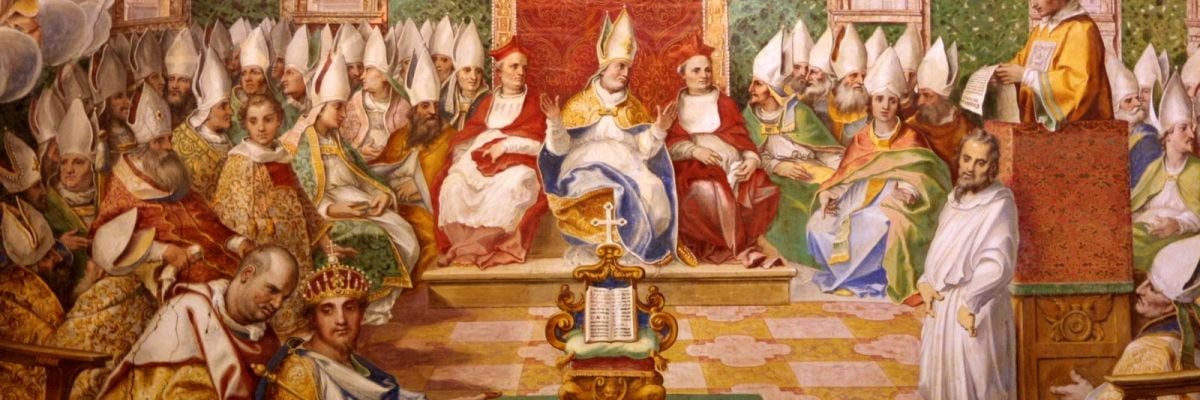
Catholics and non-Catholics alike were served up a mountain of lies and untruths in Dan Brown’s novel The Da Vinci Code. Of particular interest to apologists, of course, is Brown’s egregious account of the Council of Nicaea of 325. Brown claims that Jesus was regarded as a mere prophet until Nicaea, when council members narrowly voted to declare him divine.
Brown is hardly alone in his malicious distortions. A casual Internet survey on Nicaea reveals a grimly fascinating set of assertions, including such “truths” as:
- Emperor Constantine summoned the Council of Nicaea in order to impose the Christian faith on the empire;
- he decided the canon of the Bible when he gathered up all of the sacred writings of the time and threw them onto a large table; the ones that did not roll off onto the palace floor were declared “inspired”;
- the dogma of the Trinity was settled only by a close vote, with victory achieved by the assassination of several dissenting bishops;
- the Council ordered removed from the sacred texts—the ones not on the floor, apparently—all references to reincarnation that had been a part of Christian teaching from the beginning.
For Catholic apologists, the facts of Nicaea are far removed from the breathless imaginings of Brown and what passes for scholarship in the murkier corners of the Web. In other words, there were no assassinations, no secret plots by power-hungry emperors, and no skeletons hidden from history.
Constantine Contra Chaos
One false claim is that Nicaea was convened by Emperor Constantine to impose the Christian faith on a reluctant pagan world. The truth is, the emperor’s one purpose was to resolve the Arian controversy, which had created a major storm in the eastern half of the Roman Empire. Begun by the Egyptian presbyter Arius, this heresy questions the divinity of Christ by suggesting that the Son was a creature (albeit the first and greatest of God’s creatures), made ex nihilo. Creation was made through the Son, and hence he existed before all time, but he was not eternal. Opposition from faithful Christians began immediately, but Arius and his supporters were able to rally defenders from among some of the bishops in Palestine.
Having recently become sole emperor after his defeat of the pagan Licinius Licinianus in 324, Constantine was faced with the task of maintaining order in an imperial domain still fragile politically and unprepared to be torn asunder by a religious crisis. Preferring to be uninvolved in the goings-on of the Christian Church, despite the favor he showed to it, the emperor left it to the eastern bishops to settle the controversy. They failed to do so, however, and it was clear that there would be no easy solution to the matter as both sides were intransigent.
Constantine did not unilaterally convoke the council. Instead, as the sixth ecumenical council, the Third Council of Constantinople (680-681), declared centuries later, Constantine and Pope Sylvester assembled the Council at Nicaea. The choice of Nicaea (modern-day Iznik), in western Asia Minor, stemmed from its easy access for bishops coming from the Western Empire, good weather, and the presence of the imperial summer palace resting along the Bosporus. Although he likely received guidance from Bishop Hosius, the council’s president, Constantine was most responsible for the practical task of organizing the council, including generously providing free transportation for the bishops.
The council opened in June 325. Early historians of the Church disagree as to how many bishops were in attendance, but the most commonly accepted number is 318, although the names of only 220 are known. Less important than the number, however, were the amazing stories of the bishops who gathered.
Army of Martyrs
According to the ecclesiastical historian Theodoret, the bishops entered the council proudly, and clearly visible for all to see were the scars and mutilations they had suffered at the hands of their Roman persecutors in the years before Constantine. Bishop Paphnutius from Egypt could barely walk because his knees had been crushed, and he had only one eye; the other had been gouged out by a Roman soldier for refusing to deny that Christ was the Son of God. The hands of Bishop Paul of Neocaesaria on the Euphrates were paralyzed and hideously scarred from the Roman torturers who had used red-hot irons to try to break his faith. As Theodoret wrote, the Council resembled an army of martyrs.
The historian Eusebius chronicled that the bishops came from across the whole of the fast-growing Christian world. Most were from the East (it was still a hard journey for elderly bishops across the Empire, even if Constantine was providing transportation), and a special place of honor was given to Bishop Alexander of Alexandria, who had fought Arius so vigorously from the beginning. He was accompanied by a young secretary and theological advisor, Athanasius, who went on to earn the title “pillar of the Church” from St. Gregory of Nazianzus. Athanasius spent the rest of his life defending the Church’s teachings and faced hardship and exile at the hands of the vindictive Arians.
Pope Sylvester I was represented by two papal legates, Roman priests named Victor and Vincent, and almost certainly by Bishop Hosius. The idea that the pope had no say in the proceedings is disproved by the place of Hosius and also the fact that he and the two legates signed the conciliar decrees first. By custom, the priests should have signed only after the bishops, but their pre-eminence as papal representatives demanded the deference of the council fathers.
One in Being with the Father
Constantine began the assembly with an address in Latin. He did not command the bishops to declare Jesus to be divine, he did not throw scrolls in the air, and he did not order the deaths of reluctant bishops. He called upon the bishops to restore order in the Church. Finishing his speech, he removed himself from the subsequent deliberations.
The bishops permitted Arius to stand and present his teachings. The Egyptian priest was not without his supporters, such as Eusebius of Nicomedia, a close friend and counselor to the emperor. Nevertheless, their arguments found little sympathy among the council fathers, who saw the ramifications for the Christian faith should they embrace the Arian position. To declare that Jesus Christ was not truly God would be a betrayal of the faith that had been proclaimed from the earliest days of the Church. For the bishops it would have made a mockery of their own immense sufferings at the hands of the Romans.
There was no vote to decide whether Christ was divine. They did not need one. Instead, the fathers took upon themselves the duty to issue a formal statement of what Christians believed. The result was not some new creation, as though the bishops haggled over Christ and the beliefs of the Church. The bishops simply presented what they had been taught, which had been handed down over the previous centuries from the teachings of Christ. There were already creeds and professions of faith, such as that used by pagan converts when they entered the Christian community through baptism. The bishops could thus bring these extant creeds to their discussions. The end result was the famed Nicene Creed, in essence the one we have today: a profession of faith that included a key phrase—”one in being with the Father” (Gk. homoousion to Patri)—that affirmed without any hesitation that Jesus Christ is truly God.
To the Creed the bishops attached a set of canons and an anathema against the Arians. Initially five bishops (out of the over 300) opposed the new creed, but after persuasion from their brother bishops—not poison or torture—only two bishops remained obdurate, Theonas of Marmarica and Secundus of Ptolemais. As punishment, both were deposed. Arius himself was exiled to Illyria, and his writings were cast into the fire.
The Rest of the Story
The other pressing topics tackled by the bishops included fixing the date of Easter for the churches in the East and West, the readmission of those who had apostatized during the persecutions, the requirements for ordination to the priesthood and appointment to the episcopate, and whether priests should be allowed to take interest on loans. In sum, the bishops of the Church gathered in communion with the pope and exercised their proper authority to teach, sanctify, and govern.
Satisfied with the work of the bishops, Constantine joined in the closing session, implored the bishops to return home and labor to bring religious peace to their flocks, and asked for their prayers. He also threw a departure banquet for his honored guests.
While the council was supposed to bring a close to the Arian controversy, the hope proved fleeting, for the crisis continued throughout the fourth century as Arianism made an empire-wide comeback with the help of several emperors. But orthodox Christianity was re-established in the West and in the East, and the magnificent examples of the true faith provided by the Cappadocian Fathers (Sts. Basil, Gregory of Nyssa, and Gregory of Nazianzus) laid the groundwork for the final defeat of the Arians at the Council of Constantinople in 381.
So what happened to the declaration regarding the canon of Scripture? Well, it was never even a topic of conversation, and none of the acts of the council suggest that the canon was even on the agenda. Indeed, the fourth century is marked by discussions regarding the canon of Scripture at councils, but Nicaea was not one of them.
As for reincarnation, advocates of the New Age movement have claimed that the Church suppressed all original teachings regarding reincarnation. Shirley MacLaine, in her famous book Out on a Limb, declared, “The theory of reincarnation is recorded in the Bible. But the proper interpretations were struck from it during an ecumenical council meeting of the Catholic Church in Constantinople sometime around A.D. 553, called the Council of Nicaea” (Out on a Limb, 234-35). She is referring actually to the fifth ecumenical council, the Second Council of Constantinople, in 553 (not Nicaea, of course), but that gathering was not worried about reincarnation either. Rather, the council dealt in one line with the erroneous propositions in Origenism and its elements related to the transmigration of souls.
No doubt we will hear next that the council forgot to read the scrolls that rolled off the table.



